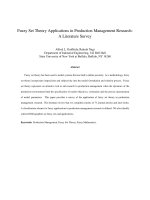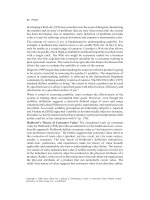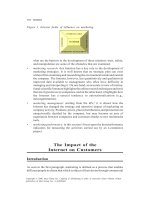Location based marketing research 2 applications in USA
Bạn đang xem bản rút gọn của tài liệu. Xem và tải ngay bản đầy đủ của tài liệu tại đây (842.6 KB, 18 trang )
1
TABLE OF CONTENTS
• Introduction
• Applications in USA
• Applications in China
• Potential applications in Vietnam
-2-
Applications in USA
-3-
Applications of LBS
• Location based service was first developed for the military and emergency services.
• Understanding device location opens doors to a wide range of use cases that are unique in many different ways.
• LBS is used for discovering places and routes, tracking, obtaining traffic updates and real-time directions, routes to
landmarks, information regarding ongoing local events, finding friends, location-based advertising, location-based
shopping, location-based social networking, and location-enabled searches. It is also used for location-based
entertainment and infotainment etc.
-4-
Applications of LBS (Communication network)
Industrial Area
Solutions
Example of providers
Asset management
Product/people/vehicle tracking
Information provision
Infotainment services, travel and
Echosec System
tourist guides, travel planner, mobile NewsON
yellow pages, shopping guides
Security (including civil security)
Emergency call (Police, ambulance),
automotive assistance
AmtelNet
Navigation
Directions, indoor routing, car park
guidance, traffic management
Google,
Waze
Process analytics
Monitoring the usage of storage
areas and traffic routes in shop,
monitoring the occupancy rate of
meeting rooms at office
Celayix Software
-5-
myGeoTracking
Applications of LBS (Communication network)
Non-industrial Area
Solutions
Example of providers
Billing
Road tolling, location sensitive tolling
Signalsoft
Games
Mobile games, geo catching, destination exploration/team
building
Pokemon Go
Strayboots
Social Network
Connect people by locations
Banjo
Zenly
Pet care
Check pet locations, connect pets and pet owners
Twindog, Kippy
Parent-child monitoring
Take care of children, monitor and control children activities
Mobile Fence
Advertising
Location based advertising for Retail/Natural-related business
Blue Dot
HR Recruitment
Search and recruit people in the region
JobKaster
Agriculture
Support both cultivation and husbandry activities
GPS trackit
Lets Nurture
Outdoor fitness/event
organization
Create, advertise and manage event/outdoor fitness activities
Calisthenics Parks
All Events
-6-
LBM Approaches
There are two approaches:
• Push Approach: Target mobile devices of customers who have ‘opted-in' to receive ads. Based on the
data regarding audience’s age, preferences, interests, etc., send a marketing message based on
customers’ locations.
• Pull Approach: Target users who are looking for your brands/products or services (the users themselves
request an ad). Send marketing message whenever user search you on devices.
-7-
LBM Techniques (1)
Location based marketing can be used in a variety of ways:
• Geo-Aware Targeting: Use real-time data location from a mobile service provider to display ads to
customers close to your location.
• Geo-Targeting with user input: Based on the user’s location, ask the user what kind of ads they would
want to receive, their other preferences, etc. Since the data has directly come from the user, you can
send specifically targeted and relevant ads. For example, after registering for an advertiser’s service, the
user can see ads and deals from nearby food outlets, clothing stores, accessory shops, etc.
• Geo-Fencing: With Geo-Fencing, focus on potential customers within a pre-defined radius in a given
location. Marketers generally use Geo-Fencing in combination with Geo-Conquesting to target
customers visiting rival stores. By creating a virtual fence for a location (predefined or dynamic), you can
serve ads to those who step inside your fence. For example, Walmart’s app has a store mode, which
delivers coupons or deals and e-receipts when a customer is around a Walmart store. This nudges
customers to buy more from that Walmart store.
• Geo Conquesting: marketers try to lure away customers who are visiting competitors using locationbased ads. The idea is – the customer is in the rival’s shop to purchase a product or service you have. By
promoting your product with an exciting deal, you are not only creating brand awareness but are also
compelling the customer to make a purchase.
Source: MarTech Advisor 2019
-8-
LBM Techniques (2)
• Hyper Contextual Targeting: Use location as well as other contexts to target customers with meaningful
ads. Marketers use geographic location in combination with past locations visited, intent based on
search history, geography specific events, or weather, etc. to serve them relevant ads. For example,
marketers target users with ads for indoor activities on a rainy or cold day and outdoor events on a
warm sunny day.
• Geo Exclusion: It is a feature where many ad service providers, like Google Ads, allow you to exclude
specific locations where you can prevent the ad from showing. You could omit poorly performing
locations or locations where your ads do not have a target audience. For example, if you are promoting
your business in a locality, you could exclude a school in the vicinity, where it could cause a distraction.
• Keyword Targeting: Use of keywords to limit targeting around a location is another geo-advertising
technique. Instead of relying only on location, you focus on specific keywords that fit your campaign or
are better suited for that location. These keywords lead searchers to the results about local businesses.
The customers need not be in the location; it is their intents that matter.
Source: MarTech Advisor 2019
-9-
Applications in US
Top LBS providers in US:
• Apple: established its presence in the LBS market with the Indoor maps and 3D digital maps enabled with
turn-by-turn spoken directions, interactive 3D views, and flyover features.
• Foursquare: develops mobile applications that allow users to check-in and share real-time location with
friends. It helps users to access a database with information regarding food, shopping and entertainment to
interact with other users and merchants.
• Google: offers a broad range of LBS solutions, for example, Google Maps provides useful information, such
as the location of ATMs, restaurants, and fuel stations, based on the site of the users. Other LBS services
offered by them are Google Now, Google Maps, Google Search and knowledge graph among others.
• HERE: offers maps and location experiences on multiple screens and OS. It also provides mobile, web and
enterprise solutions in automotive, mobile and internet, commerce, as well as consumer electronics sectors.
• Aisle411: is a trusted indoor location services platform for global leading retailers and venue owners,
offering value to the facilities management, digital, marketing and loyalty teams. The company provides
mobile retail navigation services and a social shopping platform, which helps shoppers find the required
services and receive reward points.
• Facebook: Facebook Places marks the company’s first foray into the LBS market, which is gaining popularity
with users who want to share where they shop, eat or play.
Source: Technavio 2017
- 10 -
Applications in US
• Location targeting advertising within mobile
sold by all providers (which includes pure
play, radio, television and newspapers) is
projected to grow from $17.1 billion in 2017
to $38.7 billion in 2022, a 17.8 percent
compound annual growth
• Top LBM providers:
o Foursquare
o Google
o Groupon
o xAD
- 11 -
Case Study: Shopkick
Shopkick
•
•
•
•
•
Founded in 2009
Headquarters: Redwood City, California
Website:
Concept: Connecting shoppers with brands and retailers throughout the entire path to purchase
Description: Shopping app for smartphones and tablets that offers users rewards for shopping
activities both online and in-stores such as watching ads, walking into stores, scanning items,
making in-app or in-store purchases and submitting receipts. Users are awarded "kicks" for these
actions, and can exchange them for rewards in the form of mobile gift cards. The app is available
for iOS (both iPhone and iPad) and Android devices
• Technology: GPS, inaudible audio signal unique to each store, audio/iBeacon hybrid with Bluetooth
Low Energy (BLE) (shopBeacon)
• Achievements: As of April 2017, Shopkick had driven over 200 million store visits, over 270 million
product scans in aisle, and over $2.5 billion in total sales from brand and retail partners and was
ranked the most engaging shopping app by App Annie in 2017
- 12 -
Case Study: Shopkick
Shopkick helps brands and retailers solve many business objectives:
•
•
•
•
Incremental Sales
Drive category consumption
Shift share from competitors
Motivate new shoppers to visit stores
Motivate current customers
to shop more frequently
Protect Margins
• Drive sales without the use of coupons
or discounts
• Upsell and cross-sell in-store, before
checkout
• Utilize tactics which are brand-aligned
Product Awareness
• New product launches
• Drive consumers to shelf and aisle instore
• Educate consumers about products
Location-Based Marketing
• Reach consumers anytime, anywhere
with contextually relevant content
• Actionable insights from 1st-party
location data
- 13 -
Applications of LBM_Benefits
• Location-based marketing has become increasingly popular and more affordable — making it a valuable tool
for businesses. The main reasons to use geomarketing are:
o Generate more businesses: Location-based marketing gets the business in front of its consumers when
they are most interested in purchasing the product or service (e.g local fitness centers attract customers
in the area)
o Make segmentation easier: Location is one of the best ways to segment a group. If marketers can
determine where someone is at a given moment, they can create a message that is tailored to that
specific location — making it more relevant to that consumer
o Provide a better ROI: Collecting, analyzing, and using location data can help marketers generate more
engagement on their promotions and improve the return on the advertising spending
• Brands with physical locations (consumer packaged good brands, retail locations, food and dining
establishments, grocery stores) are the best fit for location-based marketing. This is a good choice for auto
dealers, travel & tourism boards, or even e-commerce companies
Source: The Balance Small Business 2019
- 14 -
Applications of LBM_Limits
This specialized marketing technique is a great fit for most, but not all industries. These limits can be both
in the quality and quantity of data, as well as regulatory and compliance restraints:
• Privacy regulations: ITP (Intelligent Tracking Prevention), ad blockers or data protection regulation will
be huge challenges for mobile & in-app ads industry in 2018, requiring action from programmatic ads
strategists to adapt to the situation
• Location choice: Choosing a single location without abundant foot traffic to analyze, events that do not
last long enough to capture the right audience, or smaller markets with limited data to begin with.
Sometimes marketers also find location-based audiences challenging when businesses are clustered
tightly together or on-top of one another, like in malls or multi-use buildings.
• Too common goods: Products that are ubiquitous and can be found in a variety of locations (soft drinks,
pet food) don’t benefit from location derived insights. These marketers should use other targeting
methods, such as demographics and purchase history, to reach their audience more effectively.
• Businesses with sensitive data: Brands of certain locations, such as healthcare offices, can pose another
challenge for location-based campaigns given the sensitive nature of the data.
- 15 -
Trends of LBM (1)
1. Augmented Location
• Augmenting location with data about user behavior patterns enables a brand to create more
timely, customized user engagement.
• Augmented location will change the course of mobile marketing, by identifying the right time
for user engagement, transforming mobile marketing by enabling marketers to solve problems,
using context to create targeted notifications that would prove useful and relevant.
2. Beacon Technology
• This technology has taken time to mature.
• Proximity marketing will become a priority for marketers in 2019, and the beacon network will
make it possible to send highly targeted messages as a person moves from location to location.
• Beacons offer opportunities such as location targeting, customer mapping, visit tracking,
targeting with related products and cross-selling. They can also guide users in big shopping
centers, offer rewards and send promotional messages.
- 16 -
Trends of LBM (2)
3. Hyperlocal Marketing
• Hyperlocal marketing is about targeting customers in a geographically restricted area or even a
specific destination. It is an excellent strategy for small as well as large businesses, as you can
craft extremely relevant and targeted messages to the set of customers at a particular location
and capitalize on the fact that a customer is more likely to buy from the area she resides in or
can walk to.
• Proximity Marketing Apps will also show an upward trajectory, through which customers can
exercise full control over the messages and notifications they receive. This will help in sending
out relevant messages without spamming the customer.
• Other marketing strategies that you can incorporate in hyperlocal marketing efforts include:
o Beacon technology (as mentioned above)
o Community-based marketing
o Local influencers
o Priority-based individual customer experiences
o Locally relevant content such as newsletters, emails
4. Mobile App Localization
Companies will invest more in creating localized app versions to suit local needs for a better user
experience, which, in turn, will create substantial opportunities to tap different markets.
Source: MarTech Advisor 2019
- 17 -
TO BE CONTINUE…
- 18 -









